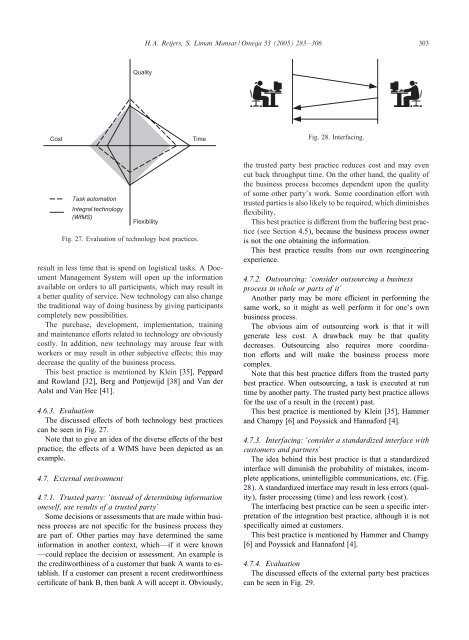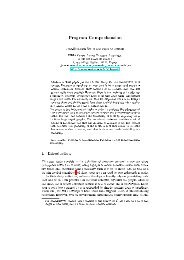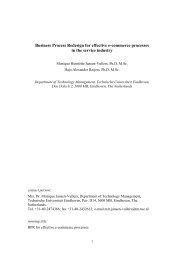Best practices in business process redesign: an overview and ...
Best practices in business process redesign: an overview and ...
Best practices in business process redesign: an overview and ...
Create successful ePaper yourself
Turn your PDF publications into a flip-book with our unique Google optimized e-Paper software.
Cost<br />
Task automation<br />
Integral technology<br />
(WfMS)<br />
Quality<br />
H.A. Reijers, S. Lim<strong>an</strong> M<strong>an</strong>sar / Omega 33 (2005) 283 – 306 303<br />
Flexibility<br />
Fig. 27. Evaluation of technology best <strong>practices</strong>.<br />
Time<br />
result <strong>in</strong> less time that is spend on logistical tasks. A Document<br />
M<strong>an</strong>agement System will open up the <strong>in</strong>formation<br />
available on orders to all particip<strong>an</strong>ts, which may result <strong>in</strong><br />
a better quality of service. New technology c<strong>an</strong> also ch<strong>an</strong>ge<br />
the traditional way of do<strong>in</strong>g bus<strong>in</strong>ess by giv<strong>in</strong>g particip<strong>an</strong>ts<br />
completely new possibilities.<br />
The purchase, development, implementation, tra<strong>in</strong><strong>in</strong>g<br />
<strong>an</strong>d ma<strong>in</strong>ten<strong>an</strong>ce e orts related to technology are obviously<br />
costly. In addition, new technology may arouse fear with<br />
workers or may result <strong>in</strong> other subjective e ects; this may<br />
decrease the quality of the bus<strong>in</strong>ess <strong>process</strong>.<br />
This best practice is mentioned by Kle<strong>in</strong> [35], Peppard<br />
<strong>an</strong>d Rowl<strong>an</strong>d [32], Berg <strong>an</strong>d Pottjewijd [38] <strong>an</strong>d V<strong>an</strong> der<br />
Aalst <strong>an</strong>d V<strong>an</strong> Hee [41].<br />
4.6.3. Evaluation<br />
The discussed e ects of both technology best <strong>practices</strong><br />
c<strong>an</strong> be seen <strong>in</strong> Fig. 27.<br />
Note that to give <strong>an</strong> idea of the diverse e ects of the best<br />
practice, the e ects of a WfMS have been depicted as <strong>an</strong><br />
example.<br />
4.7. External environment<br />
4.7.1. Trusted party: ‘<strong>in</strong>stead of determ<strong>in</strong><strong>in</strong>g <strong>in</strong>formation<br />
oneself, use results of a trusted party’<br />
Some decisions or assessments that are made with<strong>in</strong> bus<strong>in</strong>ess<br />
<strong>process</strong> are not speci c for the bus<strong>in</strong>ess <strong>process</strong> they<br />
are part of. Other parties may have determ<strong>in</strong>ed the same<br />
<strong>in</strong>formation <strong>in</strong> <strong>an</strong>other context, which—if it were known<br />
—could replace the decision or assessment. An example is<br />
the creditworth<strong>in</strong>ess of a customer that b<strong>an</strong>k A w<strong>an</strong>ts to establish.<br />
If a customer c<strong>an</strong> present a recent creditworth<strong>in</strong>ess<br />
certi cate of b<strong>an</strong>k B, then b<strong>an</strong>k A will accept it. Obviously,<br />
Fig. 28. Interfac<strong>in</strong>g.<br />
the trusted party best practice reduces cost <strong>an</strong>d may even<br />
cut back throughput time. On the other h<strong>an</strong>d, the quality of<br />
the bus<strong>in</strong>ess <strong>process</strong> becomes dependent upon the quality<br />
of some other party’s work. Some coord<strong>in</strong>ation e ort with<br />
trusted parties is also likely to be required, which dim<strong>in</strong>ishes<br />
exibility.<br />
This best practice is di erent from the bu er<strong>in</strong>g best practice<br />
(see Section 4.5), because the bus<strong>in</strong>ess <strong>process</strong> owner<br />
is not the one obta<strong>in</strong><strong>in</strong>g the <strong>in</strong>formation.<br />
This best practice results from our own reeng<strong>in</strong>eer<strong>in</strong>g<br />
experience.<br />
4.7.2. Outsourc<strong>in</strong>g: ‘consider outsourc<strong>in</strong>g a bus<strong>in</strong>ess<br />
<strong>process</strong> <strong>in</strong> whole or parts of it’<br />
Another party may be more e cient <strong>in</strong> perform<strong>in</strong>g the<br />
same work, so it might as well perform it for one’s own<br />
bus<strong>in</strong>ess <strong>process</strong>.<br />
The obvious aim of outsourc<strong>in</strong>g work is that it will<br />
generate less cost. A drawback may be that quality<br />
decreases. Outsourc<strong>in</strong>g also requires more coord<strong>in</strong>ation<br />
e orts <strong>an</strong>d will make the bus<strong>in</strong>ess <strong>process</strong> more<br />
complex.<br />
Note that this best practice di ers from the trusted party<br />
best practice. When outsourc<strong>in</strong>g, a task is executed at run<br />
time by <strong>an</strong>other party. The trusted party best practice allows<br />
for the use of a result <strong>in</strong> the (recent) past.<br />
This best practice is mentioned by Kle<strong>in</strong> [35], Hammer<br />
<strong>an</strong>d Champy [6] <strong>an</strong>d Poyssick <strong>an</strong>d H<strong>an</strong>naford [4].<br />
4.7.3. Interfac<strong>in</strong>g: ‘consider a st<strong>an</strong>dardized <strong>in</strong>terface with<br />
customers <strong>an</strong>d partners’<br />
The idea beh<strong>in</strong>d this best practice is that a st<strong>an</strong>dardized<br />
<strong>in</strong>terface will dim<strong>in</strong>ish the probability of mistakes, <strong>in</strong>complete<br />
applications, un<strong>in</strong>telligible communications, etc. (Fig.<br />
28). A st<strong>an</strong>dardized <strong>in</strong>terface may result <strong>in</strong> less errors (quality),<br />
faster <strong>process</strong><strong>in</strong>g (time) <strong>an</strong>d less rework (cost).<br />
The <strong>in</strong>terfac<strong>in</strong>g best practice c<strong>an</strong> be seen a speci c <strong>in</strong>terpretation<br />
of the <strong>in</strong>tegration best practice, although it is not<br />
speci cally aimed at customers.<br />
This best practice is mentioned by Hammer <strong>an</strong>d Champy<br />
[6] <strong>an</strong>d Poyssick <strong>an</strong>d H<strong>an</strong>naford [4].<br />
4.7.4. Evaluation<br />
The discussed e ects of the external party best <strong>practices</strong><br />
c<strong>an</strong> be seen <strong>in</strong> Fig. 29.






